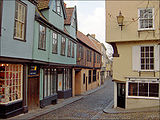
Elm Hill, Norwich
Encyclopedia

Norwich
Norwich is a city in England. It is the regional administrative centre and county town of Norfolk. During the 11th century, Norwich was the largest city in England after London, and one of the most important places in the kingdom...
, Norfolk
Norfolk
Norfolk is a low-lying county in the East of England. It has borders with Lincolnshire to the west, Cambridgeshire to the west and southwest and Suffolk to the south. Its northern and eastern boundaries are the North Sea coast and to the north-west the county is bordered by The Wash. The county...
with many buildings dating back to the Tudor period
Tudor period
The Tudor period usually refers to the period between 1485 and 1603, specifically in relation to the history of England. This coincides with the rule of the Tudor dynasty in England whose first monarch was Henry VII...
.
It is a famous Norwich landmark and features the Briton's Arms coffee house, The Stranger's Club and the famous Dormouse bookshop.
It is frequently used as a film set for TV and movie productions - most recently Stardust.
The street
Elm Hill today extends from the Church of St. Peter Hungate where the top of Elm Hill meets Princes Street, to the Church of St. Simon and St. Jude, sited at the bottom of Elm Hill on the corner with Wensum Street. It used to continue in a straight line past Britons Arms and intersect with St Georges Street but was re-aligned in the 15th century in order to permit the construction of St Andrew's & Blackfriars Halls which were originally the home of the Dominican friars.Elm Hill acquired its name from the elm trees that have successively stood in the square since the first quarter of the 16th century when the Churchwardens of St Peter Hungate Church planted the first one. (The tree you see today is not an elm because of the presence of Dutch elm disease in the UK). The parish pump, though not the original, is sited near the tree.
There is no record of the date when Elm Hill first came into being, but there is some evidence for its existence around A.D. 1200. Very few buildings standing above ground in Elm Hill are of an earlier date than 1507, when a disastrous fire destroyed over 700 houses in Norwich. Britons Arms may be older.
Although it may not be immediately apparent today, the North side of Elm Hill runs parallel to the river Wensum and in the past many of the Merchant houses had their own quays. During the 15th and 16th centuries Elm Hill and the river were important commercial thoroughfares. The river was the route from which raw materials were imported and finished products exported via Great Yarmouth. At this time there was industrial prosperity in Norwich due largely to the arrival of religious refugees from Europe and the settlement of a large number of weavers, dyers, goldsmiths and other skilled craftsmen.
Many wealthy merchants had their houses facing Elm Hill with their factories and workshops at the rear. Between them and the river were the homes of their workpeople.
Elm Hill has provided sixteen recorded citizens to serve Norwich as Mayor or Sheriff.
With the gradual decline of Norwich as a centre of the weaving industry in the 19th Century, Elm Hill lost its importance and slowly degenerated into a slum area. By 1926 where once stood the fine houses of the merchants there was only neglect and decay. The areas leading down to the river, whilst still inhabited, were scenes of poverty and squalor.
In 1927 the Norwich Society
Norwich Society
The Norwich Society was established in 1923 to help preserve the historical buildings in Norwich, Norfolk. It aims to promote high quality town planning within the city.The Norwich Society...
, carried out a detailed survey and report on Elm Hill, forwarding this, with their recommendations, to the Norwich Corporation for their
consideration. The report made it clear that despite the shocking condition of the Elm Hill area there still remained much of historic and architectural value and that with a general clearance of the slums, and sympathetic renovation of some of the more important buildings, it could once again become an important area of interest.
The Norwich Corporation wanted to demolish and build a swimming pool on the north side of the street but at the last moment was persuaded to adopt the ideas from the Norwich Society. Renovation work commenced in 1927. The Corporation purchased some of the properties, the slums were largely demolished and further purchases were made after the war. Today, with a few exceptions, Norwich City Council still owns most the buildings.

